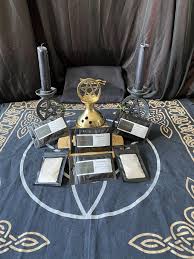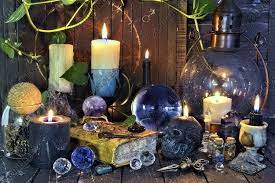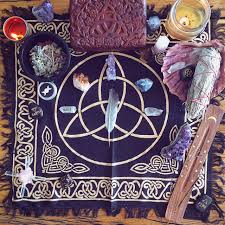Altar Cloths.
A variety of coverings, can be used for the Altar, depending upon the ritual and the season. Attractively patterned sarongs, are sometimes used for this purpose.
Beverages.
A variety of drinks; be they fruit juices, wines, or liqueurs, can be consumed during your rituals, rites, and spell workings.
Candles.
These candles can include, votives, tapers, jar, shaped, tea light candles in various colors.
Natural tallow, and beeswax candles, are always good at adding an extra dimension to your working.
Ultimately though, if you wish to keep things simple, all you need are some plain white candles.
You can always change the color, of a white candle, by using crayons.
Furthermore, you could tie a ribbon, of the color called for in the spell around the base of the candle. From that, it will take on that color’s energy of the candle.
Charcoal Disks.
Charcoal disks can be used for resin incense, such as copal,or dragons blood.
Cloths.
A variety of cotton cloths, of a solid colour, can be used in spell crafting.
These cloths can be used for, wrapping tarot cards, crystals, stones, holding herbs, making poppets, herbal dream pillows, and so on.
Cords.
The cord, designating the three styles of green practice ,wild witch, hedgewitch, green witch, kitchen witch, may be gold, for energy worker within a cultural tradition.
Red, can be used for working with the Powers of Nature.
Black, can be used for dedication, to the Goddess, and to the God.
As many styles as have been used, such colors may be combined or braided together.
The symbology is, gold for energy work, red for powers, and black for wisdom and union, with the Divine.
Glass Bottles.
Glass bottles. can be used. for herbs, oils, moon water, spell work, and storage of other items as needed.
An idea, maybe to, Rinse these bottles, with spring water, and sea salt, to cleanse before use.
Herbs.
A variety of herbs can be stocked in labeled containers.
Incenses.
Incenses, such as stick, cone, resins, in a variety of fragrances, will undoubtedly, add magick to your Altar.
Charcoal disks, made for incense, may be needed if using resins.
Light incense, look for glow, then wave to extinguish the flame so only smoke results.
Matches.
Matches may be regular, or of the long stick variety. Alternatively use a lighter.
Musical Instruments.
For musical instruments, you could use drums, bells, flutes, harps, sistrums, cymbals, gourd rattles, other rattles, to aid in meditation, spell casting, energy raising, etc.
Oils.
A variety of essential oils, including, rosemary, sandalwood, lavender, benzoin, rose geranium, frankincense, pine, Juniper, mint, can be used for anointings.
It may be a good idea, not to use cinnamon, as it will burn.
You may also need carrier oils, such as, olive, sunflower, almond, jojoba, coconut, and so on, for mixing own fragrance blends.
Often, the easiest thing to do, if you cannot find the required essential oil, is to go back to basics. Instead of dabbing with clove oil, push a clove into your clothes.
Instead of rubbing a candle with basil oil, rub a basil leaf on it.
Sometimes, oil is necessary though. Making your own essential oils is difficult, though not impossible.
If nothing else, you could make an infused oil.
Use a simple, plain carrier, such as almond or olive oil.
Put some in a small bottle, add your chosen herb, such as rosemary, and leave this to infuse for one lunar month.
Salt.
Sea salt, rock salt, can be used in rituals, spell work, and cleansings, as well as Circle Castings.
Spring Water.
Springwater can be collected in a natural spring and stored for use in spell work and ritual. Failing that, it can be bought pre-packaged.
Stones.
A variety of crystals, semi-precious stones, river and Earth stones for use in spells, healing, and aura work.
Threads.
Threads. or embroidery floss, of various colors, can be used for tying up magical works.
Tiles and Trivets.
Tiles or Trivets can be used under items that will burn hot, such as cauldrons, to avoid scorching a surface beneath.




